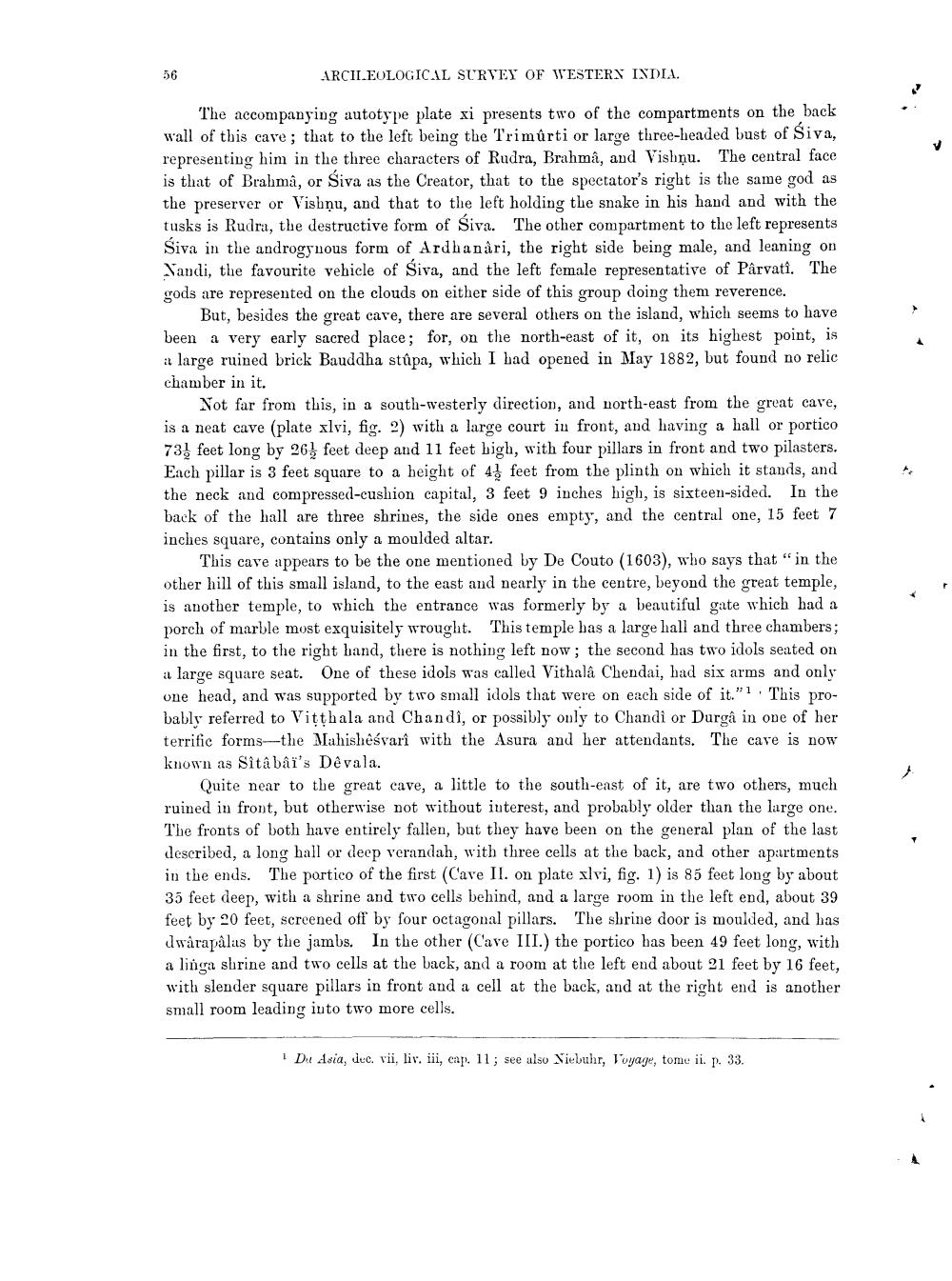________________
ARCILEOLOGICAL SURVEY OF WESTERN INDIA.
The accompanying autotype plate xi presents two of the compartments on the back wall of this cave; that to the left being the Trimurti or large three-headed bust of Śiva, representing him in the three characters of Rudra, Brahma, and Vishnu. The central face is that of Brahmâ, or Śiva as the Creator, that to the spectator's right is the same god as the preserver or Vishnu, and that to the left holding the snake in his hand and with the tusks is Rudra, the destructive form of Śiva. The other compartment to the left represents Siva in the androgynous form of Ardhanari, the right side being male, and leaning on Nandi, the favourite vehicle of Siva, and the left female representative of Pârvati. The gods are represented on the clouds on either side of this group doing them reverence.
But, besides the great cave, there are several others on the island, which seems to have been a very early sacred place; for, on the north-east of it, on its highest point, is a large ruined brick Bauddha stúpa, which I had opened in May 1882, but found no relic chamber in it.
56
Not far from this, in a south-westerly direction, and north-east from the great cave, is a neat cave (plate xlvi, fig. 2) with a large court in front, and having a hall or portico 73 feet long by 26 feet deep and 11 feet high, with four pillars in front and two pilasters. Each pillar is 3 feet square to a height of 4 feet from the plinth on which it stands, and the neck and compressed-cushion capital, 3 feet 9 inches high, is sixteen-sided. In the back of the hall are three shrines, the side ones empty, and the central one, 15 feet 7 inches square, contains only a moulded altar.
This cave appears to be the one mentioned by De Couto (1603), who says that "in the other hill of this small island, to the east and nearly in the centre, beyond the great temple, is another temple, to which the entrance was formerly by a beautiful gate which had a porch of marble most exquisitely wrought. This temple has a large hall and three chambers; in the first, to the right hand, there is nothing left now; the second has two idols seated on a large square seat. One of these idols was called Vithalâ Chendai, had six arms and only one head, and was supported by two small idols that were on each side of it." This probably referred to Vitthala and Chandi, or possibly only to Chandi or Durga in one of her terrific forms the Mahishêśvari with the Asura and her attendants. The cave is now known as Sitâbâï's Dêvala.
Quite near to the great cave, a little to the south-east of it, are two others, much ruined in front, but otherwise not without interest, and probably older than the large one. The fronts of both have entirely fallen, but they have been on the general plan of the last described, a long hall or deep verandah, with three cells at the back, and other apartments in the ends. The portico of the first (Cave II. on plate xlvi, fig. 1) is 85 feet long by about 35 feet deep, with a shrine and two cells behind, and a large room in the left end, about 39 feet by 20 feet, screened off by four octagonal pillars. The shrine door is moulded, and has dwarapalus by the jambs. In the other (Cave III.) the portico has been 49 feet long, with a linga shrine and two cells at the back, and a room at the left end about 21 feet by 16 feet, with slender square pillars in front and a cell at the back, and at the right end is another small room leading into two more cells.
Du Asia, dec. vii, liv. iii, cap. 11; see also Niebuhr, Voyage, tome ii. p. 33.




